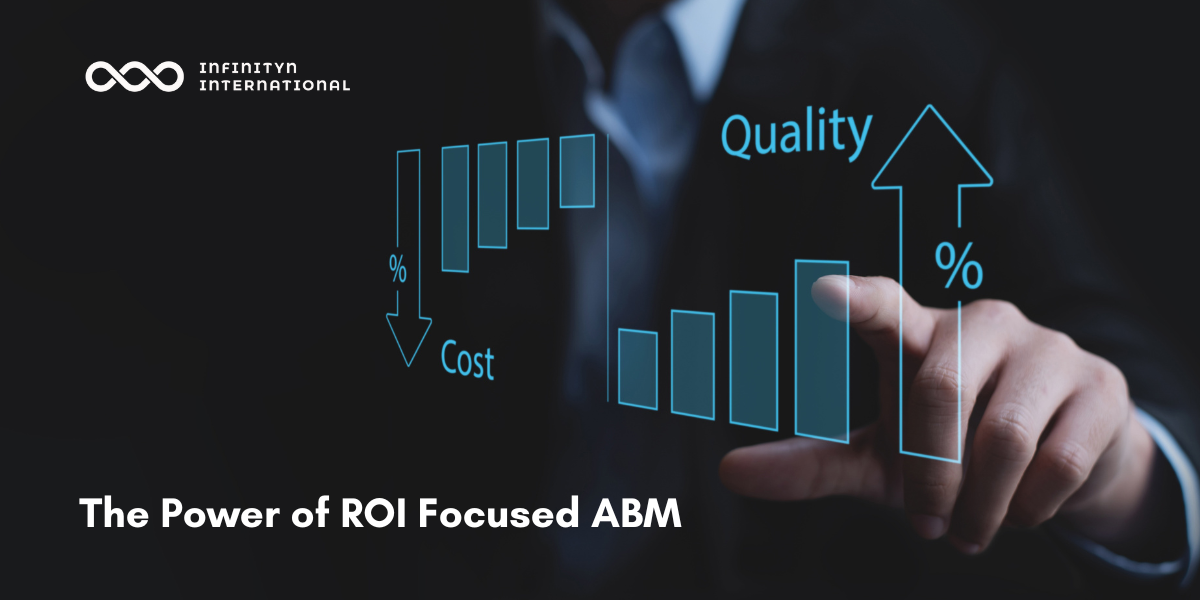Finding the Perfect Agile Account-Based Marketing Partner
What we call agile account-based marketing (AABM), is a newly emerging discipline. As such, the industry of marketing service providers - agencies...
5 min read
-1.png) Admin
:
Feb 28, 2023 5:52:02 AM
Admin
:
Feb 28, 2023 5:52:02 AM

Account-based marketing has been all the rage in the B2B world with big promises, new lingo, new buzzwords. We’ve been finding that it isn’t always easy for C-suite to get as enthusiastic about ABM, as it is for marketing and sales. In this article, we’re approaching ABM from a VP/C-suite stance, attempting to highlight its benefits for revenue officers and those whose day-to-day concern is the organization’s bottom line. We won’t be shy about revealing ABM’s achilles heel, but also have a cure for it.
On a windy November afternoon in London, a client was analyzing intent-data in her Demandbase (ABM platform) account. Intent data reveals insight such as website searches performed by people and ties the data to particular organizations. This time, what had caught her attention: people from a global enterprise were conducting an increasing number of searches for terms highly relevant to their solution. Quick research about the account revealed a neat fit with their ideal customer profile.
Could this account become an opportunity? It certainly “looked right.” The marketer didn’t want to spend weeks hoping that they would turn up as an MQL in their automation platform. Traditional ABM thinking would default to putting this company on the list for their IP-targeted ads, where they start targeting employees of the target company with digital ads. Once they click on an an ad, the target account would be served personalized, industry-specific or even company-specific content.
Then hopefully, several website visits, a few whitepaper-downloads and webinars later, a marketing-qualified lead would emerge. However, this client of ours, as mentioned previously, did not want to wait and opted for a simple and agile, no-nonsense approach.
Luckily, they had Infinityn on their side, an ABM-agency who was at home with agile and no-nonsense approaches, and whom they could just forward the company’s name to. We would engage C-suite to verify whether the intent is real and find potential champions in the organization who can help sell the solution. The result?
Two weeks later, our client had not one, but five sales qualified leads. We had qualified the leads against budget, authority, need, timeline. Product demos also had been set up for the inside sales team. The account turned out to be a promising one indeed, but they may have never turned up as a target account, had our client opted for digital targeting only. This quick and agile move added an “unexpected” hundreds of thousands of dollars to the pipeline.
Now it is common practice for many Infinityn clients to initiate their one-to-one and one-to-few ABM plays with data-backed human outreach. We immerse ourselves in intent data and supplement traditional digital outreach with talent. It's a straight forward, but incredibly effective approach.
Many ABM and account-based sales teams don’t have capacity to personally act on signals from promising accounts. They opt for slow and uncertain digital marketing techniques which do great in a one-to-many ABM scenario, but are not the best way for those “whale prospects” who deserve a personalized approach from the very beginning.
We call this data-driven but human-centered approach agile account-based marketing or AABM. We have found it is a key component that drives fast ROI from ABM. In addition, we’re seeing agile ABM to be a cure to a pressing issue surrounding sales and marketing...
One of the hottest topics in ABM nowadays is sales-marketing alignment, and with a good reason. The covid-crisis only amplified the tendency of marketing being called out to “prove their worth”. Namely, to show that their activity can (in)directly be attributed to revenue. Without close cooperation with sales, this is impossible.
This trend is turning marketers’ focus away from vanity metrics such as page views, downloads and even leads. The focus is shifting towards actually qualified leads and conversations.
Agile ABM emerged because marketers started to look for ways to have real impact on revenue and to engage key accounts in the most efficient way possible. In the remainder of this article, we’d like to walk you through the logic of going from poor leads and misalignment, to great leads and synergy between sales and marketing.
When B2B marketing is done right, marketing is actually accountable for revenue-contribution. This sometimes scares marketing management. However, sharing important KPIs between sales and marketing is key. Evidence shows that when teams have the same targets, alignment comes almost naturally. When both marketing and sales are measured on contribution to revenue, “magic happens” and collaboration emerges; alignment happens.
It is worth examining one of the main sources of misalignment between the two departments: the expectation that “marketing should deliver a lot of leads”. It has also (falsely) been regarded as the antidote to sales and revenue problems: “Sales lagging behind? Let’s add more leads!” The issue with digital leads is the same as with all good things in life. After a certain inflection point, quality doesn’t scale with quantity. In fact, lead quality diminishes when digital leads are acquired at scale.
So it is this “tradition” of scoring marketing’s output based on the quantity of MQLs that has led to serious deficiencies in the B2B world. Marketers are being “torn apart” by sales demanding quality from one end, and management demanding quantity in leads on the other.
Chris Walker of RefineLabs told a story that illustrates this incoherence. The case was of a tech CMO, whose problem was a common one: every time they hit a target in digital leads at the end of the quarter, their superior raised the bar by 20% for the following quarter. While putting immense pressure on marketing to deliver big numbers, nobody really stopped and asked, what happens to these digital leads. That is, nobody, except for the head of sales. The marketing and sales leaders were beginning to have increasingly uncomfortable conversations about the quality of leads that marketing delivers for them.
Dumping a huge number of junk leads on SDRs burns the candle at both ends. First, it wastes marketing’s budget, who acquire those leads at a growing per-lead cost. Second, it wastes sales resources, who call up MQLs that turn out to be lacking three or four components from the budget-authority-need-timeline criteria. The solution for most marketing organizations has been to shift from lead-focus to account-focus, hence account-based marketing emerged.
While this shift happened on a theoretical level, old habits still prevail. One problem for marketing teams doing ABM has been that the over-reliance on conventional digital marketing- tools. As you could see from the case of the software vendor at the beginning of the article, with high profile and high-intent accounts, speed and agility are necessary. Sometimes marketing has to - literally - pick up the phone and talk to people. Kind of like what salespeople do - which can be a bit of a stretch for a marketing-mindset. If marketing doesn’t have the skill and resources to do that, it should outsource it - otherwise, marketing can’t deliver on the promise that marketing is increasingly expected to do: handing over high quality leads to sales. Which is exactly how marketing makes the largest contribution to bottom line.
While much of B2B marketing and sales is now account-based, it helps if the process is nuanced in terms of giving more attention to large, key accounts. In ABM terminology, this is known as one-to-one ABM (as opposed to one-to-few and one-to-many ABM.) Often the missing piece of the puzzle in 1:1 ABM is the personal, human touch from marketing.
Including this missing piece of the puzzle really amps up pipeline velocity and including the human outreach delivers really spectacular results. If you’d like to learn about how Infinityn complements ABM teams to deliver these results, take a look at how we can help.

What we call agile account-based marketing (AABM), is a newly emerging discipline. As such, the industry of marketing service providers - agencies...

Growth process outsourcing is BPO for complex sales and marketing processes. Business process outsourcing (BPO) is a familiar term for most in the...

Evolving the SDR Role The business landscape is in constant flux, and with it, the role of the Sales Development Representative (SDR) must evolve. As...

Helping your future customers advance from RPA initiative to great ROI By Kyle Hansen & Yuriy Koshulap

What’s the philosophy behind the technology of the most successful ABM programs? Answering this question was not the original intent when we set out...
%202.jpg)
Marketing goes beyond promotion. Marketing is creativity, profound planning, understanding of your audience, analysing data – especially nowadays,...

What is the best way to accurately map out your buyers’ decision making process? Having a deep understanding of the buyer persona is fundamental to...

If you’ve clicked on this article, there’s a fair chance you are considering outsourcing your sales, marketing, customer success and overall revenue...

In the ever-evolving marketing strategies, Account-Based Marketing (ABM) has emerged as a powerful approach that focuses on targeting specific...

B2B strategies can be pretty intricate. But anyone who knows B2B knows that the tricky part isn't the strategy itself, but the execution. At least...

In the dynamic world of B2B marketing, Account-Based Marketing (ABM) has surfaced as a game-changing strategy, yielding significant returns on...